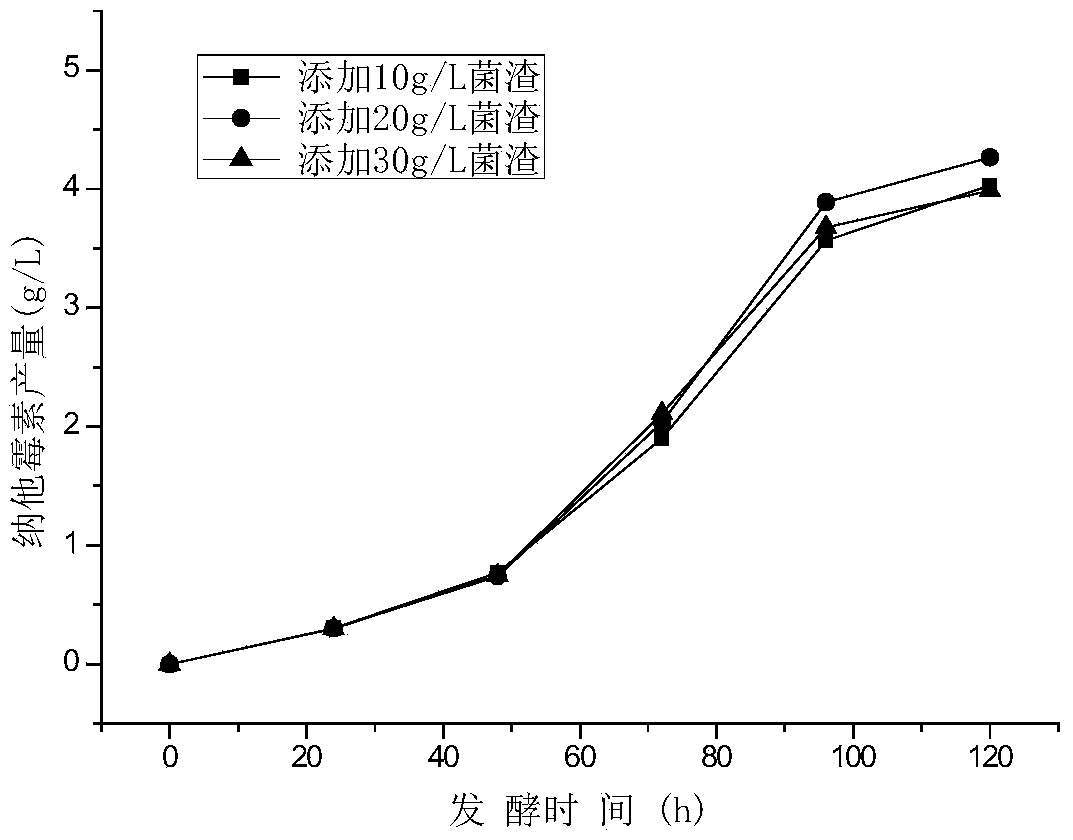Method for preparing high-yield natamycin by using crypthecodinium cohnii ATCC30772 fermented waste mushroom dregs
A technology of ATCC30772 and natamycin, which is applied in the field of high-yield natamycin by fermenting waste fungus residue of Cryptodinium koiformis ATCC30772, which can solve problems such as undiscovered, reduce pollution, increase production, and reduce production costs
- Summary
- Abstract
- Description
- Claims
- Application Information
AI Technical Summary
Problems solved by technology
Method used
Image
Examples
Embodiment 1
[0033] 1) Preparation of Cryptidium kelpium ATCC30772 fungus residue: activate Cryptidium kelpium ATCC30772 preserved on a slant and put it into a 250ml Erlenmeyer flask containing 50ml of seed medium, culture it at 25℃﹑90r / min for 3 days, then press 10 % of the inoculum was inoculated into a 500ml Erlenmeyer flask containing 100ml of fermentation medium, and cultivated for 9 days at 20°C. The obtained fermentation liquid was centrifuged to obtain bacterial precipitates, washed three times with distilled water, dried in an oven at 80°C, and ground into powder.
[0034] 2) Shake flask seed culture: under aseptic conditions, spread the spores of Streptomyces natalis on the agar slant medium, culture them in the culture room at 28°C, and then configure the cultured Streptomyces natalis experimental strains Sporulation suspension, draw 1ml of this suspension and add it to the triangular flask of seed medium (glucose 10g / L, yeast powder 50g / L, yeast extract 5g / L, pH 7.2), shake the...
Embodiment 2
[0041] 1) The preparation of Cryptidinium koii ATCC30772 fungus residue is the same as in Example 1;
[0042] 2) The shake flask seed cultivation method is the same as in Example 1;
[0043] 3) Shake flask fermentation culture: Inoculate the cultivated seed liquid with 10% inoculum in the Erlenmeyer flask of fermentation medium (glucose 10g / L, soluble dextrin 40g / L, yeast powder 30g / L, pH 7.2) , shake the flask at 220 rpm, 28° C., and cultivate for 120 h. 0.6% sodium propionate was added at 24 hours of fermentation, and 10g / L, 20g / L and 30g / L of Cryptidinium koesili ATCC30772 fermentation waste residue (the rest time is not added). When the fermentation ended, the natamycin output in the fermented liquid reached 4.791g / L, 5.044g / L and 4.841g / L respectively by HPLC method measurement (see figure 2 ).
Embodiment 3
[0045] 1) The preparation of Cryptidinium koii ATCC30772 fungus residue is the same as in Example 1;
[0046] 2) The shake flask seed cultivation method is the same as in Example 1;
[0047] 3) Shake flask fermentation culture: Inoculate the cultivated seed liquid with 10% inoculum in the Erlenmeyer flask of fermentation medium (glucose 10g / L, soluble dextrin 40g / L, yeast powder 30g / L, pH 7.2) , shake the flask at 220 rpm, 28° C., and cultivate for 120 h. 0.6% sodium propionate was added at 24 hours of fermentation, and 10g / L, 20g / L and 30g / L of Cryptidinium koesili ATCC30772 fermentation waste residue (other time is not added). When the fermentation ended, the natamycin output in the fermented liquid reached 4.031g / L, 4.266g / L and 3.987g / L respectively by HPLC method measurement (see image 3 ).
[0048] As can be seen from the above examples, the whole fermentation process is only added once and 10g / L, 20g / L and 30g / L of Cryptidinium koiformis ATCC30772 are added to the ...
PUM
 Login to View More
Login to View More Abstract
Description
Claims
Application Information
 Login to View More
Login to View More - R&D
- Intellectual Property
- Life Sciences
- Materials
- Tech Scout
- Unparalleled Data Quality
- Higher Quality Content
- 60% Fewer Hallucinations
Browse by: Latest US Patents, China's latest patents, Technical Efficacy Thesaurus, Application Domain, Technology Topic, Popular Technical Reports.
© 2025 PatSnap. All rights reserved.Legal|Privacy policy|Modern Slavery Act Transparency Statement|Sitemap|About US| Contact US: help@patsnap.com



